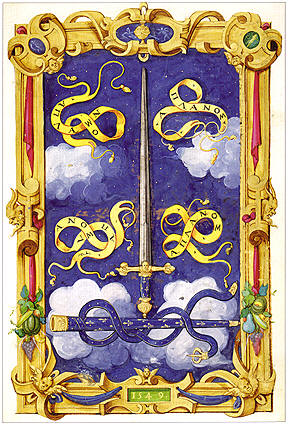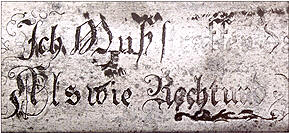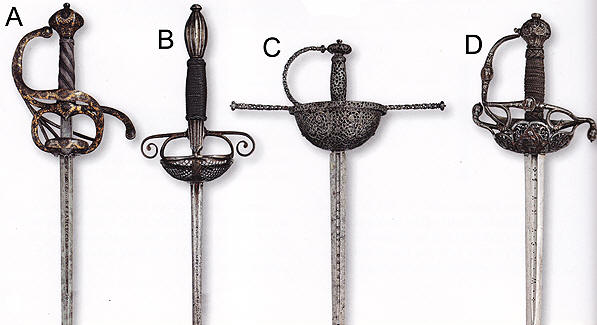Swords of the Renaissance
The soldier of the mid-i
500s witnessed dramatic advances in military
technology. Swords, bows and pikes were now being
challenged by early artillery, hand-held guns and
complex siege weapons. In response, combatants
became more heavily armored. The sword evolved from
being a purely slashing weapon to one that could
pierce and break through plate armor. New sword
types also appeared, from the huge two-handed
broadsword of the Landsknecht to the handy
short-bladed falchion of the ordinary infantryman.
The Estoc or Tuck
Sword
Stiff, lozenge or
diamond-shaped thrusting blades were now replacing
the wide-bladed and cruciformhilted swords typical
of the medieval period. This new type of sword was
known to the French as an estoc and to the English
as a tuck. The estoc featured a long, two-handed
grip, enabling the bearer to achieve maximum effect
as he thrust the sword downwards into armor. This
sword was particularly effective at splitting
chainmail and piercing gaps in armor. Due to the
narrowness of the blade, it had no discernible
cutting edge but a very strong point. Opponents who
had lost the protection of their armor during the
heat of battle were still dispatched by the
traditional double-edged cutting sword, held in
reserve for just such an eventuality. Versatility
and a range of weapons to hand was still an
important and practical factor.
Downward-curving cross guard

ABOVE:
A Polish estoc, which would have been used by the
cavalry. The needle-like blade was ideal for
penetrating armor.
The
“hand-and-a-half” Sword
Common throughout
Europe from the beginning of the 15th century, the
“hand-and-a-half sword” is also referred to as a “longsword”.
The contemporary term “bastard sword” derives from
it being regarded as neither a one-handed nor a
two-handed sword. Despite these perceived drawbacks,
it possessed a reasonably long grip and shorter
blade, which allowed one hand to hold the narrow
grip firmly, while a couple of fingers placed
strategically on the forte gave the soldier extra
leverage and maneuverability when wielding. The
length of these swords was around 115—145cm
(45.3—57in).

ABOVE:
The “hand-and-a-half” sword has
a short
grip that
accommodates one hand, while the fingers of the
second hand are placed on the blade forte to allow
extra leverage and control when swinging the blade.
The Falchion
Although the
falchion’s design had originated in ancient Greece,
the sword experienced a widespread revival during
the Renaissance, particularly in Italy, France and
Germany. This short-bladed sword had a straight or
slightly curved blade, with cross guards either
absent or very simple.
The falchion was
primarily a side-weapon and was usually carried by
the infantry. Because of its short blade and ease of
maneuverability, the falchion became the precursor
to the hunting sword.

ABOVE:
This Milanese ceremonial falchion, c.1600,
features a strong, broad blade with curved,
double-edged point.
Two-handed (Zweihänder) Swords
Very large broadswords called Zweihänder or two-
handed swords, became very popular during the 15th
and 16th centuries, and are probably best known for
their association with the famed Landsknechte, or
mercenaries. Established during the reign of the
Holy Roman Emperor, Maximilian 1(1459—1519), and
drawn mainly from Germany and eastern Europe,
Landsknechte fought in numerous battles throughout
the continent, particularly during the Italian Wars
of 1494—1 559.

ABOVE:
A two-handed Zweihänder sword from
c.1550,
used by mercenaries employed by the Holy Roman
Emperor.
Their Zweihänder swords had a length of up to 1 .8m
(5.9ft) and weighed 2—3.5kg (4.4—7.7lb). The hilt
was of massive form, with extremely large
pommels and hilt
guards. The sword could also be utilized as a form
of short lance when gripped firmly at the blade
forte. Because of its immense size, the Zweihänder
would also have been extremely effective at
attacking and breaking up massed ranks of infantry
or pikemen.
Another sword
favored by the Landsknechte was the Katzbalger
(cat-skinner or brawler), a short sword, or hanger.
It was a sturdy, wide-bladed sword, with a
distinctive “figure-of-eight” guard. It was 75—85cm
(29.5—33.5in) long. The sword’s name is thought to
derive from the practical reality that it would have
been a weapon of last resort and used in close,
confined combat, when the soldier would literally
have to fight like a cornered feral cat. The
Landsknecht carried it alongside his Zweihänder.

ABOVE:
The Katzbalger was a secondary sword of the
Landsknecht, and used when his larger, two-handed
sword was unavailable.
The Cinquedea, or
“five-fingered” Sword
Another distinctive short sword that developed in
Italy during the Renaissance was the cinquedea. The
shape and form of the cinquedea typifies the
Renaissance belief in the importance of artistry,
combined with a newly rediscovered passion for the
classical world. It was worn mainly with civilian
dress and comprised a very wide blade of
five-fingered span. The hilt was normally of
simple form, with a severely waisted grip. Because
of its wide blade, many swordsmiths took the
opportunity to embellish the swords with exquisite
engraving and gilding. The sword would have been
worn in the small of the back in order that it could
be drawn laterally.
There is some debate as to
whether the cinquedea was actually a dagger rather
than a sword. The average length is noted at
40—50cm/16—l9in (and there are even two-handed
versions known), so this probably indicates that the
cinquedea fits more comfortably within the broad
family of swords rather than dagger types.

ABOVE:
A cinqueda sword, with typical
pronounced medium ridge, or spine, running down the
centre of the blade.
Ceremonial Swords
 The
increasing power and wealth of the European
monarchies and city states during the Renaissance
meant that the sword did not only serve a purely
military function. It also became a manifestation of
the rank and status of the privileged, and its most
notable appearances were at royal coronation
ceremonies. Although the medieval cruciform-hilted
sword had fallen out of favor on the Renaissance
battlefield, being superseded by more complex and
enclosed-hilt forms, it was still retained for
ceremonial purposes
—
perhaps recalling a
more “knightly” time
—
when a gentleman or
courtier swore allegiance to his king by the kiss of
a knightly sword. These “bearing” swords were
carried before kings, queens and senior clergy. The
sword of Frederick I of Saxony, presented to him by
Emperor Sigismund I of Germany in 1425, has a
cruciform hilt inset with rock crystal and heavily
gilded in gold and silver. There is also a massive
15th-century bearing sword, supposedly made for
either Henry V of England or Edward, Prince of
Wales, which has a total length of over 228cm
(88.6in). Ceremonial swords were also presented as
symbols of state office. From the 14th century
onwards, English mayors were granted the right
(usually by the monarch) to carry a great civic
sword on ceremonial occasions. This tradition was
upheld for centuries and many historic towns in the
United Kingdom still retain these swords. The
earliest recorded civic sword still in existence is
to be found in Bristol and is thought to date from
around 1373. Constables of France, including such
notables as Bertrand du Guesclin and Anne de
Montmorency, carried bearing swords. The
increasing power and wealth of the European
monarchies and city states during the Renaissance
meant that the sword did not only serve a purely
military function. It also became a manifestation of
the rank and status of the privileged, and its most
notable appearances were at royal coronation
ceremonies. Although the medieval cruciform-hilted
sword had fallen out of favor on the Renaissance
battlefield, being superseded by more complex and
enclosed-hilt forms, it was still retained for
ceremonial purposes
—
perhaps recalling a
more “knightly” time
—
when a gentleman or
courtier swore allegiance to his king by the kiss of
a knightly sword. These “bearing” swords were
carried before kings, queens and senior clergy. The
sword of Frederick I of Saxony, presented to him by
Emperor Sigismund I of Germany in 1425, has a
cruciform hilt inset with rock crystal and heavily
gilded in gold and silver. There is also a massive
15th-century bearing sword, supposedly made for
either Henry V of England or Edward, Prince of
Wales, which has a total length of over 228cm
(88.6in). Ceremonial swords were also presented as
symbols of state office. From the 14th century
onwards, English mayors were granted the right
(usually by the monarch) to carry a great civic
sword on ceremonial occasions. This tradition was
upheld for centuries and many historic towns in the
United Kingdom still retain these swords. The
earliest recorded civic sword still in existence is
to be found in Bristol and is thought to date from
around 1373. Constables of France, including such
notables as Bertrand du Guesclin and Anne de
Montmorency, carried bearing swords.
RIGHT:
Sword and scroll of Anne de Montmorency, 1493—1567,
from the
Hours of Constable Anne de Montmorency.
In terms of sheer brilliance of decoration and
craftsmanship, the ceremonial swords presented by
the Renaissance popes must rank as the apogee of
16th-century sword decoration. Given with a richly
embroidered belt and cap by the pope each year on
Christmas Day, invariably to members of the European
Catholic nobility, these great two-handed swords
were fabulously ornate and featured a profusion of
precious stones and extensive gold and silver
metalwork.
 The
Development of Hunting Swords The
Development of Hunting Swords
Hunting had always been the favored and exclusive
pursuit of the nobility since the early medieval
period and Renaissance hunters continued this
pastime with vigor. The depiction of the royal hunt
was a popular subject for artists and many painters
and weavers of tapestry found the drama of the chase
and final kill with sword and spear irresistible.
The falchion sword, or short hanger, was well known
to the infantry as a side-weapon. It was first
adopted during the 14th century, specifically as a
dedicated hunting weapon. In later years, a saw-back
blade was also incorporated for ease of cutting up
the kill, followed by the development of a
specialist set of tools for pairing. This
combination of sword and skinning tools was known as
a garniture, or trousse. As the owners of these
hunting swords invariably had great financial means,
decoration of the swords became ever more elaborate.
RIGHT:
An
illustration of a hunting sword with pommel and
crossbar decorated by birds’ heads. It has a
saw-back blade for cutting the kill.
Swords of
Justice, Swords of Execution
Great swords were also employed as both symbols and
facilitators of judicial law. Many local courts of
justice placed a large bearing or executioner’s
sword on the courtroom wall. The presence of the
executioner’s sword was not purely symbolic for it
had a practical application in the actual beheading
of prisoners. It was often highly decorated and
engraved with prayers for the condemned, warnings
against transgressions and vivid images of
beheadings, hangings and torture.

ABOVE
This German executioner’s sword has a double-edged
blade with a blunt, lightly rounded point. Many
surviving “execution swords” are actually swords of
justice which would be carried before the judge to
indicate his power over life and death.

ABOVE:
In this detail from the above sword, an etched
inscription
can be seen. In German it reads
“Ich Muf straffen daI verbrechen
—
Als wie Recht und Richter sprechen”.
Translated, this means “I have
to punish crime as the law and judge tell me”.
Executioners’ swords were more common in continental
Europe from the 1400s, particularly Germany, with
England still preferring the axe. The sword hilt was
normally of conventional cruciform shape with a
large counter-balancing pommel. It was very well
constructed, with high-quality steel used for the
manufacture of the blade. The blade edge was
extremely sharp and it was a requirement of the
executioner to keep it well honed so that the head
of the victim could be severed in one mighty blow.
Blades were broad and flat backed, with a rounded
tip. The sword was designed for cutting rather than
thrusting, so a pointed tip (as in the case of
military blades) was unnecessary.
An executioner’s
sword in the British Museum, London, has the
following words engraved on the blade in Latin. It
translates as: “When I raise this sword I wish the
sinner eternal life / The Sires punish mischief: I
execute their judgement.” When no longer used for
executions, swords became ceremonial.
Another sword designed solely
for the hunt was the boar sword. Based on the
triangular-bladed estoc or tuck, its greatly
stiffened blade was designed to withstand the power
of a charging boar or other large animal. The boar
sword was introduced during the
14th century and by around 1500
it had developed a faceted or leaf-shaped spear
point. A crossbar was later added near the end of
the blade to prevent an animal running up the length
of the blade and so making it difficult to retrieve.

ABOVE:
A German boar sword, c.1530. Only the bravest
of hunters
used swords rather than spears for boar hunting.
The Rapier
Spain is normally cited as the
first country to have introduced the rapier, or
espada ropera (sword of the robe), during the
late 1400s. This designation highlighted the
new-found ability for a gentleman to wear these
swords with ordinary civilian dress, rather than
needing to don his armor. Italy, Germany and England
adopted the rapier soon afterwards.

ABOVE:
A German rapier dating from c.1560—70. It has
a large spherical pommel that counterbalances the
weight of the blade.
In its most complete and
recognizable form, the rapier came into full
prominence during the early 16th century. In the
mid- 1400s, precursors of the rapier (including the
standard cruciform-hilted sword) had begun to
develop a primitive knuckle guard and forefinger
ring or loop. By 1500, a series of simple bars were
joined to the knuckle guard to form a protective
hilt. At this time, the blade was still a wide,
cutting type, and it is only well into the 16th
century that the slender rapier blade was fully
developed. This typically thin blade was deemed
impractical for use during heavy combat on the
battlefield so the rapier was viewed primarily as a
“civilian” duelling sword. The new rapier hilt,
however, was adopted by the military but with the
retention of a wider, more traditional broadsword
fighting blade.
The Blade
Sword blades were manufactured
in Toledo and Valencia (Spain), Solingen and Passau
(Germany), and Milan and Brescia (Italy). They were
sold as unhilted blades and then hilted locally at
their eventual destinations throughout Europe. Some
blades are marked by their maker, although many are
plain. Notable bladesmiths’ names include Piccinino,
Caino, Sacchi and Ferrara from Italy, .Johannes,
Wundes and Tesche (Germany) and Hernandez (Spain)..
Respected names were often stamped on blades by
lesser-known rivals to enhance the value of an
inferior sword.

A) ABOVE:
Italian rapier, c.1610. Of true swept-hilt
form, it has deep chiseling to the knuckle guard.
B) ABOVE:
A North European dueling rapier, c.1635, with
a distinctive elongated and fluted pommel.
C) ABOVE:
A Spanish cup-hilt rapier, c.1660. The cup
and hilt are extensively pierced. It has very long,
straight, slender quillons with finials to each end.
D) ABOVE:
An English rapier with a finely chiseled cup hilt,
c.1650. The blade is stamped
“Sahagum”.
|